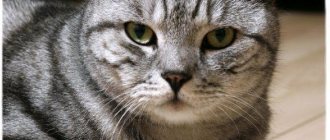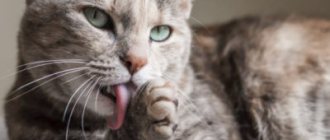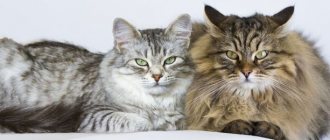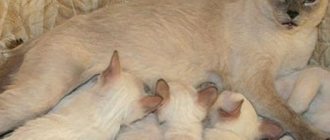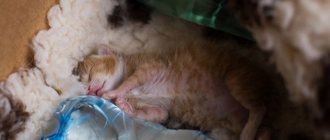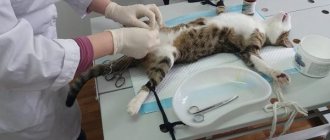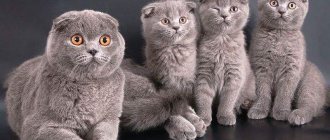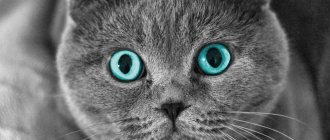The offspring of mixed feline “marriages” are often called designer animals. Through experiments, breeders try to obtain some unique appearance features or coat colors, and sometimes even hope to create a new breed group. However, the British Shorthair/Scottish Fold cross has a different story. These cats are blood relatives and are very similar in appearance. But the planned matings between them are carried out for another reason. Let's find out what kind of mestizos are born from British and Scottish breeds.
History of cats and their breeds
Cats and cats are creatures of nature, and their preferences are natural. To procreate, they choose a couple based on certain criteria, where strength, endurance and health come first, and only then external data. The domestication of cats began about ten thousand years ago, and at that time all cats did not have a specific breed, but living in different areas, they differed in appearance and character.
As cats from different areas spread throughout the world, they crossed with each other and the first mestizos appeared, which, in turn, continued to reproduce. This is how modern cats appeared, which differed in physique, length and color of fur, and character. With the development of progress, the study of genetics began and the identification of the causes of differences in the color and character of pets began, as well as their unification into separate groups - breeds.
All breeds have their stories:
- Some arose naturally without human intervention, such as the Siamese cat.
- Others are bred artificially, through long-term crossings of different species. One of the representatives is British. In fact, this is a mixed-breed cat whose parents were English and Persian domestic cats.
- For still others, the main distinguishing feature of the breed is caused by a gene mutation, for example, in Scottish cats it is folded ears. Subsequent work was aimed at preserving such features.
Today there are more than 400 cat breeds.
Mixed cats
Despite the fact that kittens from representatives of various breeds can be bright, graceful and funny, mixed breeds will never become the owners of a pedigree and will not take first places at exhibitions.
Mixed-breed cat - what is it? The answer to this question is known to every breeder, who mercilessly cull kittens born from different breeds. But many modern breeds appeared through random crossing. This is how the Broomilla breed arose from a Persian father and a Bruma mother. The first offspring was not considered a breed, but thanks to the work of the breeder, who continued to work on improving the new species, the Broomilla was recognized and included in the International Register of Pedigree Cats.
Crossbreed with Siberian cat
Similar problems can be observed in a hybrid of a Scottish and Siberian cat, which has a fairly large bone structure. In appearance, such kittens can turn out to be completely unpredictable: some will have fairly short hair, but an elongated muzzle, while others will have the opposite. But in any case, the Scottish child's face will definitely no longer exist. Kittens from a Siberian cat and a Scottish cat or vice versa - from a Scottish cat and a Siberian cat look more severe. In addition, they may develop unpredictable genetic problems. Therefore, the answer to the question whether it is possible to breed a Scottish cat with a Siberian cat is no.
Métis British
Mixed breed cats have always existed, and the British are no exception. The history of their origin began with the islands of Britain, where imported Persians were crossed with local representatives - English domestic cats. The new breed was called British. She combined English intelligence and Persian proud stubbornness.
To obtain new colors, breeders crossed this breed with their relatives, the Persians. As a result of their labors, a mixed breed of British and Persian was born. The breeding of such mestizos continued until 2003, after which it was prohibited due to signs of degeneracy in both breeds. Today, a kitten from a Persian cat and a British cat is characterized as outbred and does not receive places at exhibitions.
Also relevant were the matings of British and Scottish shorthair cats, which were used to breed Scottish Folds or Scottish Folds. Since lop ears are caused by a mutating gene, mating of two mutants is prohibited due to the risk of hereditary diseases and skeletal deformities incompatible with life in the offspring.
Who is a mestizo
The term “mixed breed” was introduced by felinologists - biologists who study the characteristics of domestic cat breeds and their breeding aimed at improvement. This term describes an animal born from the mating of two varieties.
It is fundamentally different from the so-called “culling” because kittens with a defect in color or health, but born from representatives of the same breed, are not mixed breeds. Very often, mestizos are called simple mongrel cats.
Owners who do not understand the standards of varieties and are chasing fashionable cat traits are much more pleased with a “murka” with the features of a Maine Coon or Persian than a purebred kitten for a decent amount of money.
The result of mating a Maine Coon and a regular cat
The cat and the Maine Coon were bred naturally and all efforts of the breeders are aimed at preserving their character traits:
- friendliness;
- poise;
- agreeableness;
- caution;
- lack of aggression;
- loyalty.
A Maine Coon mixed breed, obtained as a result of mating a representative of the breed with an ordinary cat, loses its characteristic features or they are distorted. The color of the coat will not change much, because most outbred cats have a color similar to the Maine Coon, but genetic traits of their ancestors may appear. Eye color will depend on the dominant color of the father or mother.
Maine Coons have medium-length hair, and if the partner was smooth-haired, then the kittens will be born with short hair.
Character, weight and body structure are difficult to calculate. A Maine Coon mixed breed can combine the traits of both parents and have different characteristics. Kittens are more massive than outbred cats, but inferior in size to purebred cats, the same applies to their character: some are affectionate, others are more aggressive.
How to distinguish from a purebred cat
The first and main difference between a purebred animal and a mestizo is the documents: the metrics of the official club.
Often in advertisements there is wording that the parents are purebred, but are not members of the club, or only one parent of the kittens has documents. At the same time, the sellers assure that the kittens are purebred and not a mixture.
British
When buying a British dog, pay attention to his coat and eye color. The common and popular color of the British cat is gray-blue or lilac; there are, of course, others, but they are less common
At the same time, the British coat is short, dense, and seems plush in appearance and touch.
The common and popular color of the British cat is blue-gray or lilac; there are, of course, others, but they are less common. At the same time, the British coat is short, dense, and seems plush in appearance and to the touch.
The eyes of purebred British dogs are bright orange. The tips of the erect ears are rounded, the muzzle is wide and flat.
A common misconception is that there is no such breed as the “British Fold”.
Maine Coon
Maine Coon mixed breeds have been a common marketing ploy in recent years.
It is very difficult to distinguish a mixed-breed kitten of this breed. But, if a kitten is offered for sale, older than three months, which has already developed the tufts characteristic of Maine Coons on the tips of its ears.
A long fluffy tail and a large body for a 3-month-old kitten also indicate a possible relationship with the Maine Coon.
Maine Coon mix
Of course, when choosing a kitten, potential owners look not so much at appearance as at character traits, dreaming of getting a kind and affectionate pet. Mixed breeds of different cat breeds inherit both the physical and mental characteristics of their parents’ breeds.
Therefore, with good care and kind attitude, mandatory vaccination and castration, any mestizo will please the eye no worse than an ordinary purebred cat.
Thai cats and their differences from mixed breeds
At the turn of the 19th and 20th centuries, Siamese cats appeared in England, but people noticed that they differed from each other in body structure and divided the breed into two types:
- cats with a strong build and rounded heads are the ancestors of today's Thais;
- graceful with an elongated muzzle - Siamese.
The Thais interested scientists and work began to improve the breed. As a result of the work, today there are three types of Thais: classical, traditional and modern.
Purebred Thai cats should have a large round head with a high forehead and a convex, powerful sternum. Almond-shaped eyes and set ears prove that the breed came from the East. Thanks to numerous crossings, the standard color of the Thais was diluted with cream, red, tortoiseshell and tabby (brindle).
By nature, these are loyal, balanced cats with high intellectual abilities, very sociable and able to change intonation.
A mixed-breed Thai cat, after crossing with a barn cat, has a pronounced external resemblance to the breed, but is fundamentally different in character due to its unbalanced psyche. Such mestizos can be aggressive and angry. This is due to the instinct of a hunter who is forced to defend his territory in the street.
If a mestizo comes from different breeds, then the traits of both parents will be visible in the character and appearance.
Metis or mongrel?
True purebred cats are significantly inferior in number to outbred and mestizo cats, the difference between which lies not only in color, but also in behavior and health. As a result of family ties that were carried out for improvement, purebred cats have numerous mutations and a number of congenital pathologies. Mestizos and outbreds are distinguished by stronger physical characteristics and immunity.
Outbred cats often have short hair, which helps with hygiene. The most common color is brindle, but tortoiseshell, blue, spotted and solid are also found. According to their external characteristics, yard cats can be divided into northern and southern types. Those living in the north are distinguished by thicker, lighter hair and stocky, large physiques, while those living in the south are darker, smoother and more graceful.
A mixed-breed cat is also a mongrel cat, but has the characteristic features of purebred cats. This is manifested in color and physique, character and health. Mixed breeds have a chance to get the breed. To do this, the owners need to breed offspring from a mixed-breed parent couple (not father and mother, but of the same breeds) and cross the offspring with each other. And only the fifth generation can become a contender for thoroughbred.
What are the good things about mestizos?
Despite the fact that mestizos cannot become winners of exhibitions, such cats can be kept as a faithful companion. They will delight you with their company and will not cause much trouble, because, unlike their purebred counterparts, mestizos are different:
- Health. Having a stronger immune system, the mestizo gets sick less often.
- Intelligence - much easier to train and get used to the tray.
- Unpretentiousness in food.
The character of a mestizo is formed from the characteristics of the breeds of his parents. Both maternal and paternal qualities or both may predominate in it. In terms of skeletal structure and aesthetic characteristics, a mixed-breed cat may be superior to its parents, but it will never become an exhibition winner.
Maintenance and care
Mixed breeds should be cared for in the same way as other cats. Brush should be done at least once a week with combs for short-haired cats. The tray should be spacious and filled with bentonite or wood. It is necessary to feed the cat with high-quality holistic, super or premium food - “Bozita”, “Farmina”, “Acana”, “Trainer”, “Pronature”, “Origin”. The diet should include lean meat, greens, low-fat cottage cheese, and hard-boiled eggs. Ears and eyes should be cleaned every week with special animal products “Beafar”, “Trixie”, “Bars”. Teeth require daily care with Dentavedin, Nutri-Vet, and Zubastik products. You should bathe your cat only when dirty. To prevent dangerous infections, your pet should be vaccinated in a timely manner.
Source
How to choose the right kitten
In order not to make a mistake when choosing a pet, it is not enough to listen only to your inner instinct. Experts advise following the basic rules:
- Ask the breeder about all the offspring to determine whether the kittens are suitable: where they grew up, what their character is, whether they were examined by a veterinarian, whether the kittens were picked up after two weeks of age.
- Have any preventive treatments and vaccinations been carried out?
- First look at mom.
- If the kittens are from a nursery, then you should find out as much as possible about the parents.
- You should not take obstinate representatives who hiss and scratch.
A healthy animal can be identified by the following signs:
- clear eyes without discharge;
- clean area under the tail;
- shine of wool;
- absence of bloating - the first sign of helminthiasis;
- energy and curiosity;
- communication with brothers;
- fearlessness.
Any kitten - purebred, mestizo or mongrel - can become the best friend and companion. He will reciprocate the sincere love and care of the owner. You should not chase expensive, fashionable and purebred cats; it is better to bring into your home a faithful and devoted companion who will not leave you in difficult times and will brighten up the melancholy of gray everyday life.
So, mating a Scottish Fold cat with a male cat is prohibited. The reason for this was active gene mutations, which can lead to death, disability or deformity of future offspring.
Owners of Scottish Fold cats often wonder how to properly breed them. Many people believe that a Scottish cat should be crossed with a cat of the same breed. In their opinion, this is the only way to breed a purebred breed and improve its qualities.
Many breeders cross the Scottish Fold and Scottish Straight breeds; they are almost the same, but the latter are straight-eared. The kittens turn out healthy, some of them have straight ears, and some have drooping ears.
At what age should you start mating?
The optimal age for mating is considered to be one and a half years . If a cat has never had kittens before two years of age, irreparable health problems may arise. During this period, the animal is completely ready for fertilization and the appearance of offspring. The first mating of Scottish cats should not occur after the first heat. The cat is not ready yet, either morally or physically; all the discharge is already unpleasant for her. Against this background, she may have a nervous breakdown, she will become aggressive and distrustful.
The best time for mating is the third or fourth day of estrus 2-3. Cats of this breed are especially active in the spring; this will not be difficult to notice; they become more irritable, refuse to eat and begin to mark corners in the house. Cats, on the contrary, are more affectionate, demand attention, and stomp their hind paws.
Advantages and disadvantages
Of course, the beauty of many cat mixes is in no way inferior to high-breed representatives of the cat world. But, nevertheless, before the owner brings a cat without a pedigree into the house, it is worth studying the pros and cons of such an animal.
The beauty of many breed mixes is in no way inferior to purebred cats.
Basic criteria for assessing a pet:
- Desired age and size of the kitten;
- Color;
- Condition of eyes, ears and paws, absence of visible signs of disease;
- Character traits that catch your eye when you first meet them;
- Knowledge of the animal's tray and scratching post.
On information resources today you can find many advertisements for the sale of kittens, but it is difficult for a beginner to determine by eye whether he is a purebred.
Sellers often mislead potential buyers with stories about mating without documents and that kitten kittens cost thousands of rubles.
In such situations, the risk of buying a mestizo instead of a purebred is very high.
And, if the buyer is still ready for this, then he should pay attention to the breed
Very popular now, fold-eared cats actually have many health problems. And if the buyer can still notice obvious diseases in the form of watery eyes or plaque in the ears, then genetic diseases, alas, cannot be noticed immediately.
How to choose the right partner
Every owner should know exactly with whom to cross a Scottish Fold cat in order to get beautiful and healthy kittens. The choice of a partner must be carried out responsibly and according to all the rules .
- It is best if the animals have similar colors and basic characteristics. This way you can breed ideal offspring that will meet all the requirements for a given breed.
- It is better not to mix different colors; this can lead to kittens with coat or eye color that is inappropriate for a Scotsman. But such breeds are considered not purebred, they are more difficult to sell and cannot be shown at exhibitions.
- It is impossible for a cat and a cat to have intercourse together if at least one of them has his ears pinned back. This can lead to defects in kittens; they are born very weak and die quickly.
- You should not breed animals if none of them have previous experience.
What does a Scotsman look like?
The breed of fold cats is divided into two breeding branches.
A cross between British and Scottish Shorthairs is characterized by the following characteristics:
- Smooth lines of the body, low legs and rounded powerful paws.
- Thick and short fur.
- More than 200 types of colors, which are divided into 3 groups: solid, tortoiseshell, tabby.
- The eyes are large, round, widely spaced. Their color should be in harmony with the coat color. Whites may have a blue tint or heterochromia.
- The muzzle is round, but the cheeks are less puffy.
- A more refined structure - the body is not as stocky as that of the “Europeans”.
- Among the American descendants of fold-eared cats, there are many animals with a modified structure of the auricle - the auditory canal is completely closed.
The American branch differs from the European:
This is interesting! Thanks to the American type, it was possible to solve the problem of a short and partially immobile tail in mixed-breed Scottish and British cats. This pathology was caused by the influence of the Fd gene on the intervertebral discs and joint structure. As soon as breeders found the opportunity to produce normal long-tailed cats, the problem of the health of the musculoskeletal system receded into the background.
What the owner should know
In order for the offspring to be healthy, you need to know some features of mating Scottish Folds:
- You need to select a partner of a similar breed, that is, Scottish, but not Scottish Fold. In this case, the best option would be Scottish Straight. This breed of cat has straight ears. If a Scottish straight-eared cat is mated, then the opposite is true, the cat must be fold-eared.
- You cannot cross a Scotsman with a British breed. In this case, the cubs are too large, the tail and head are deformed, and the structure of the coat does not meet the standards.
- The male must have a uniform color, good quality coat, and a proportional build. You should definitely pay attention to the tail, it should be flexible. This factor affects the health of the animal's spine. This way you can avoid developmental defects in the baby.
- You should also pay attention to the cat's ears. It would be correct if they are directed forward, small, widely spaced and do not extend beyond the head. An important feature is the ear folds, it is very good if they exist. Such breeds are considered unique. It is best if there are two of them, and they are tightly folded on the head. It is very rare to meet a Scot who has three such folds.
- It is important to assess the health of the male; he should not have dandruff or any discharge from the eyes, nose or ears. The animal should not be emaciated or too large, everything should be within normal limits.
Many owners of Scottish cats begin to look for a partner through advertisements. This method is not bad; you can select a suitable candidate. But there is another simple way, breeder clubs that specialize in Scottish folds . The specialists working there will be able to help you choose a suitable male and tell you about his characteristics. By choosing this method of mating, you can be sure of healthy offspring.
Before mating, it is advisable to agree on the amount of the cat’s owner’s fee. He usually gets one baby, which has straight ears. There are always fewer fold-eared kittens; it very rarely happens that all the cubs from one litter are straight. If this is the case, then the cat’s owner receives money as a reward. The amount is equal to the cost of a Scottish Fold kitten.
Before mating, it is advisable to personally make sure that both partners are treated for worms and other parasites. It is permissible to treat the cat before intercourse for diseases such as rabies, chlamydia and other diseases, as well as to prevent worms.
The room where the whole process takes place must be clean, bright, dry and spacious, and it must be warm. The intercourse of animals can last several days, so you need to be prepared for the trip. You need to take with you a tray with filler, bowls for food and water, and the food itself. It happens that a cat is very aggressive, so before mating you need to trim its claws.
Your cat may not get pregnant the first time. In this case, it is necessary to bring her to the cat on the 2-3rd day of the next estrus and leave her there for a couple of days . In one day, a cat can cover a female up to 14 times, but after a few days he ceases to be interested in her.
What difficulties may arise
- It happens that during mating a cat falls on its side. There is nothing to worry about, you just need to hold it in the required position.
- Sometimes there is such a thing as a cat being faithful to one partner. If this is the case, then you need to change the cat, since all attempts at mating will be unsuccessful.
- Another problem can be the different sizes of animals, especially a cat that is too massive. In this case, the male will not be able to cover her, grabbing the withers, he will end up on her back. Here you need the help of the owner, who will hold the cat by the withers.
- The cat may be too aggressive. In this case, mating will not work.
- It happens that due to stress, the female stops estrus. It may not exist for several days, after which it resumes. After this, the animal can be brought back to the male.
What is the owner of the male responsible for?
Before inviting a Scottish cat for mating, the owner of the male must know some rules so that the whole process does not lead to psychological and physical injuries .
- If animals have difficulties, they need help.
- Some animals can show aggression, therefore, at the slightest problem, it is better to postpone all mating actions. Maybe after a while the cats will get used to each other.
- Upon arrival at your destination, it is best to keep the cat in its portable vehicle for a while. Let her get used to it, sniff it, rest and gain strength.
- If animals are too aggressive, it is better to place them in enclosures so that they can get used to each other.
When is it possible to crossbreed a Briton and a Scot?
You can match a Brit with a Scot when:
Such matings are called experimental and are carried out in a nursery under the supervision of specialists who carefully study the litter.
Since during cross-breed mating, babies lose standard traits and have problems with the musculoskeletal system, cat owners are not advised to mate animals of the same breed.
How does the knitting process take place?
All actions take place in the territory of the male’s residence. Before breeding a Scottish Fold cat, it is contraindicated to wash it, as this will deprive it of the characteristic odor that attracts the male.
Most often, the entire process occurs without the help of the owners, but it happens that animals get lost, especially cats. In this case, they need to give time to rest, get used to it and sniff.
The male may show interest, sing songs to the female, and she, in turn, responds to his advances. If the female is not ready to mate, the male senses this and simply leaves. In this case, further actions will be ineffective; you need to wait for the next heat.
The following are the rules for mating Scottish cats:
- Age of the cat. You can take her to a male only during estrus and at the age of 1 year. Even though they reach puberty at 6-7 months, they are not yet ready to have offspring. Moreover, the animal is not yet fully formed, and this can lead to serious health problems.
- You cannot cross two Scottish Folds, or with a British male. This can lead to health problems for kittens.
- If you plan to use kittens for exhibitions, you need to take a responsible approach to choosing a partner, his pedigree, color and other characteristics.
- It is imperative to monitor the health of the animals; in case of any ailment, it is better to postpone the mating process.
If you follow all the rules, then mating a Scottish Fold cat will bring beautiful, healthy and strong offspring.
Many owners of the Scottish Fold breed are interested in the question of who can breed a fold-eared pet with, and what kind of offspring is expected from this union. The answer to this question is ambiguous and depends on the purpose of mating.
Who can a Scottish Fold cat mate with?
The Scottish Fold cat can mate with any member of the cat family, except for males of its own species, if the pet is not going to participate in various exhibitions.
The Scottish Fold cat can mate with any member of the cat family.
It is noteworthy that these animals received lop ears during selection due to a mutation , which resulted in the formation of an anomaly of the ear cartilage, which is unable to hold the ears in an upright position.
Appearance of the breed
Scotland is recognized as the homeland of the animals, but mass breeding and selection began in the United States of America.
The Scottish Fold breed is distinguished by its strong build, “plush” thick coat and high level of immunity. There is no specific characteristic color inherent in this particular breed. Individuals of this breed come in a variety of colors, but the most common is a grayish-gray tint.
For the Scottish Fold, CFA standards have been developed, according to which a cat with a medium or long tail, proportional to the body and narrowed or thickened towards the end, is suitable for exhibition.
- The head should be round, with a wide nose, expressive round and wide-set eyes.
- Rounded mustache pads, clearly defined and strong jaws and chin.
Rules for mating
To preserve the gene and obtain healthy offspring, special rules should be followed when mating females.
Puberty in females occurs around the eighth month of life . A cat will be ready for mating no earlier than one and a half or two years, depending on the individual characteristics of the animal’s body. Mating during the first heat is strictly prohibited due to the unpreparedness of the young female’s body.
Puberty in females occurs in the eighth month of life.
It is recommended to begin this process during the second, or even third, heat cycle. The third and fourth days of estrus are considered favorable. Before the event, the cat must have all the necessary vaccinations and deworming. The first mating should occur with a strong and experienced male.
Is it possible to crossbreed a Briton and a Scot?
All cat breeds have a common genetic sex pattern and the same number of chromosomes, so they can be bred with each other. In the process of breeding history, the Scottish Fold (low-eared) breed was formed.
Mating between this breed is strictly prohibited. Both partners have a gene for lop ears, which leads to genetic mutations. It was possible to get rid of the defect by crossing Scottish Fold cats with straight-eared British cats.
To maintain the standard of the Scottish breed, it was allowed to breed Britons with Scots, although matings between them were prohibited in the British breed.
The litter belonged to the Scots, they were recorded as:
Gradually, the appearance of the Scots began to differ significantly from the British. The ears, body size, length of paws and tail have changed. Unlike British cats, Scottish cats are lighter in bone, smaller in size, have a rounded head with huge eyes, small ears, and long hair. They are harsher in character.
Straight ears are the only difference between the Scottish Straight and the Scottish Fold. The World Cat Federation has registered the Scottish Straight as "Scottish Shorthair". The breed received the right to participate in the championship. To preserve the breed characteristics of the Scots, Folds stopped crossing with the British and started with Scottish Straights.
Kittens born from two British parents are considered British. If other representatives of the breeds participated in the crossing, the breed characteristics deteriorated. As a rule, the color of the British is blue. When crossed with exotics and Persians, the shade of the coat changed to other colors - smoky, black.
Why you can’t cross a fold-eared cat with a fold-eared cat
To maintain breed standards, it is recommended to cross with a cat of the Scottish Straight breed - Scottish Straight.
Cat of the Scottish Straight breed.
It is prohibited to crossbreed with representatives of the same species as a cat due to the fact that the characteristic gene will lead to the birth of non-viable offspring.
Complications during pregnancy
Pregnancy will be complicated by miscarriage or the born kittens will have abnormalities of the musculoskeletal system.
The choice of male will depend on the similarity of coat color to obtain the most even color of the offspring and the same eye color. It is noteworthy that the female must remain in the male’s territory for two or three days, necessary for closer acquaintance and mating itself. A litter may have kittens with floppy ears and kittens with straight ears.
Kittens can be born with either straight ears or fold ears.
With whom is it allowed to cross a fold cat?
Crossbreeding with British Shorthair males is allowed in order to recruit a new set of gene pool.
British shorthair cat.
The offspring from several such crosses are subsequently mated with a Briton and the British Fold or kittens with half-dropped ears are obtained.
British and Scottish cat mix
Most often you can find a mixture of British and Scots. It’s not even entirely appropriate to call them a mestizo of the British and Scots, because... According to some felinological systems, it is allowed to record such a litter as purebred Scots. Previously, such matings were generally carried out often and were a variant of the norm, because The Scottish breed at the first stages was obtained, among other things, from crossings with the British. But now the breed is established and does not need such matings. With proper crossbreeding, a cat that is a mixture of a Scotsman and a Briton can look very impressive. But this doesn't happen so often.
Basically, from the crossing of British and Scots, either defective individuals are born, or with insufficiently expressed breed qualities. In addition, a cross between a British and a Scot may have musculoskeletal problems.
President of the International Feline Association Elena Shevchenko
For a long time, the process of selecting couples was not regulated in any way. As a result, a significant number of straights of completely different types were obtained. Matings with the British breed result in British-type straight cats - rather heavy, squat, with a round head, a short thick tail, almost corresponding to the standard of a British cat. Matings with medium-type British dogs and other straights result in straights of “no type” - stretched out, the head is not round enough, the tail is long, the legs are high, the eyes are deep set. According to breed standards, the advantages of a British cat are the disadvantages of a Scottish cat. As a result of such matings, the type of both the British and the Scottish type deteriorated.
However, kittens resulting from the mating of a British and a Scot are considered a Scottish breed. It is recorded in documents, because, for example, the WCF rules do not prohibit crossing the British with the Scots. As Britons, such a litter cannot be recorded.
Features of pregnancy in fold-eared cats
The course of pregnancy in lop-eared females differs from other representatives of the cat family.
Due to the calm nature of this species, there are no mood swings, bursts of aggression, or isolation. The mother carries the kittens for approximately nine weeks. At the end of the mating, the animal calms down, becomes affectionate, and willingly makes contact with members of the household.
Pregnancy can only be determined after two or three weeks. The nipples change color, swelling and a more pink tint are observed. However, these signs are characteristic only of young animals; in older cats - older than three years of age - such signs may not appear.
Pregnancy can be determined after two to three weeks.
First half
The first half of pregnancy is characterized by increased appetite.
At this stage, fish feeding should be stopped to avoid the destruction of B vitamins, as they contribute to the normal development of embryos. It is necessary to increase the amount of food containing calcium: dairy and lactic acid products in the form of cottage cheese, milk, sour cream, kefir, yogurt.
Cottage cheese will be useful for a cat in the first half of pregnancy.
Second half
The second half passes calmly and only further growth of the abdomen and an increase in overall weight are observed.
In the second half of pregnancy, growth of the abdomen is observed.
It will be possible to determine the number of fold-eared and straight-eared kittens only after twenty-two days. At the first stage, the entire brood looks exactly the same, and they cannot be distinguished.
Third week
By the end of the third week, the cartilage begins to mature and strengthen, and everything falls into place. In Fold kittens, the ears curl even more and bend towards the head, while in Straights they gradually straighten.
By the end of the third week, kittens' cartilage begins to strengthen.
